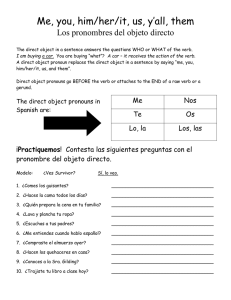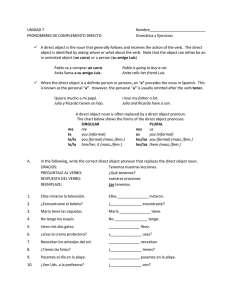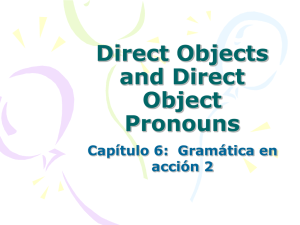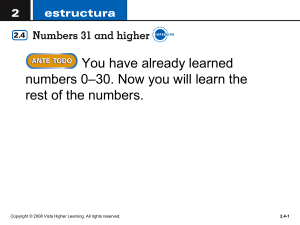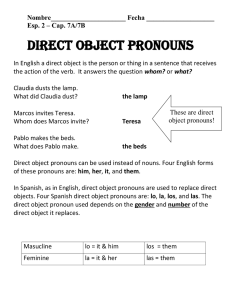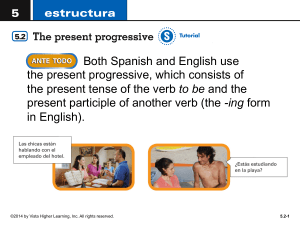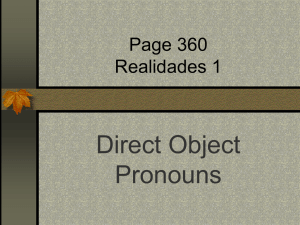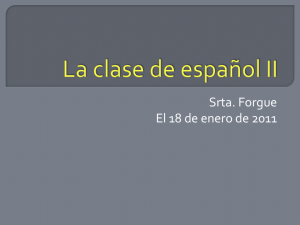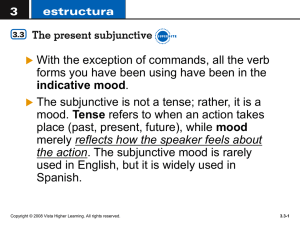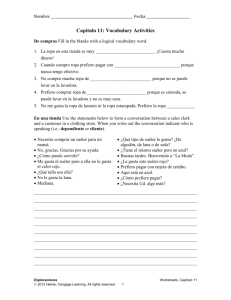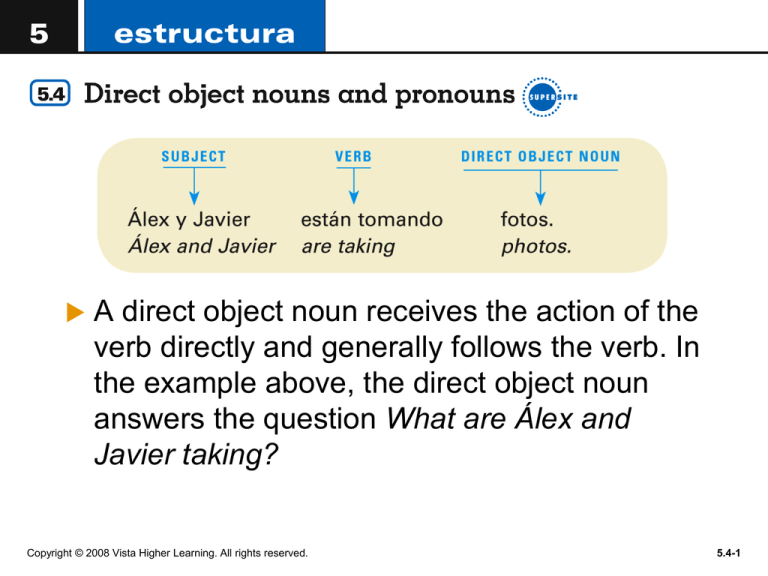
A direct object noun receives the action of the
verb directly and generally follows the verb. In
the example above, the direct object noun
answers the question What are Álex and
Javier taking?
Copyright © 2008 Vista Higher Learning. All rights reserved.
5.4-1
When a direct object noun in Spanish is a
person or a pet, it is preceded by the word a.
This is called the personal a; there is no
English equivalent for this construction.
Copyright © 2008 Vista Higher Learning. All rights reserved.
5.4-2
The personal a is required when the direct
object is a person. The personal a is not
required when the direct object is a place, not
a person.
Copyright © 2008 Vista Higher Learning. All rights reserved.
5.4-3
Copyright © 2008 Vista Higher Learning. All rights reserved.
5.4-4
Direct object pronouns are words that replace
direct object nouns. Like English, Spanish
sometimes uses a direct object pronoun to
avoid repeating a noun already mentioned.
Copyright © 2008 Vista Higher Learning. All rights reserved.
5.4-5
In affirmative sentences, direct object
pronouns generally appear before the
conjugated verb. In negative sentences,
the pronoun is placed between the word
no and the verb.
Copyright © 2008 Vista Higher Learning. All rights reserved.
5.4-6
When the verb is an infinitive construction,
such as ir a + [infinitive], the direct object
pronoun can be placed before the conjugated
form or attached to the infinitive.
Copyright © 2008 Vista Higher Learning. All rights reserved.
5.4-7
When the verb is in the present progressive, the
direct object pronoun can be placed before the
conjugated form or attached to the present participle.
¡Atención! When a direct object pronoun is attached
to the present participle, an accent mark is added to
maintain the proper stress.
Copyright © 2008 Vista Higher Learning. All rights reserved.
5.4-8
Choose the correct direct object pronoun for each sentence.
1.
Tienes el libro de español. c
a. La tienes. b. Los tienes. c. Lo tienes.
2.
Voy a ver el partido de baloncesto.
a. Voy a verlo. b. Voy a verte. c. Voy a vernos.
3.
El artista quiere dibujar a Luisa con su mamá.
a. Quiere dibujarme. b. Quiere dibujarla. c. Quiere dibujarlas.
4.
Marcos busca la llave.
a. Me busca. b. La busca. c. Las busca.
5.
Rita me lleva al aeropuerto y también lleva a Tomás.
a. Nos lleva. b. Las lleva. c. Te lleva.
Copyright © 2008 Vista Higher Learning. All rights reserved.
5.4-9
Choose the correct direct object pronoun for each sentence.
(cont’d)
6. Puedo oír a Gerardo y a Miguel.
a. Puedo oírte. b. Puedo oírlos. c. Puedo oírlo.
7. Quieren estudiar la gramática.
a. Quieren estudiarnos. b. Quieren estudiarlo. c. Quieren estudiarla.
8. ¿Practicas los verbos irregulares?
a. ¿Los practicas? b. ¿Las practicas? c. ¿Lo practicas?
9. Ignacio ve la película.
a. La ve. b. Lo ve. c. Las ve.
10. Sandra va a invitar a Mario a la excursión. También me va a invitar a mí.
a. Los va a invitar. b. Lo va a invitar. c. Nos va a invitar.

